
Features
Revving up excellence: Unveiling the results of Michigan State Police’s 2024 Vehicle Trials
April 8, 2024 By Dave Brown
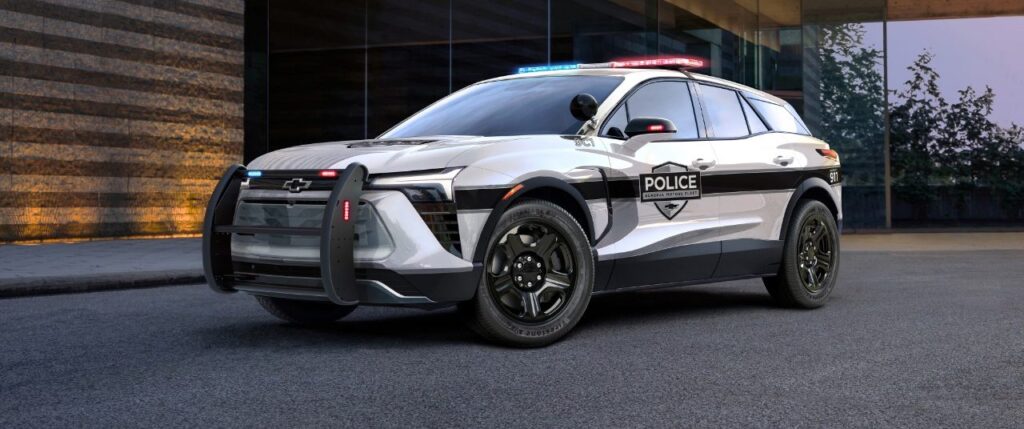 2024 Chevrolet Police Blazer EV from General Motors. Photo: General Motors
2024 Chevrolet Police Blazer EV from General Motors. Photo: General Motors Every fall the Michigan State Police, in conjunction with the U.S. National Institute of Justice (NIJ), test the handling and performance of every new police vehicle on the market for the coming year in back-to-back acceleration, braking and lap time tests. These eagerly anticipated tests are seen as the most comprehensive analysis of police vehicles in North America.
While there is no strict definition of the term “pursuit-rated,” agencies such as Michigan State Police and Los Angeles County Sheriff’s Department document and test every model offered for sale in North America. They agree that a pursuit-rated police vehicle must be able to handle higher stresses than normal, plus perform better at high speeds than their civilian counterparts. It will be up to individual agencies to determine if a particular vehicle is suitable for their mission.
The Michigan State Police yearly vehicle test for the 2024 model year will mark the 26th year that Blue Line has been compiling and reporting the results of the tests for pursuit-rated police category vehicles. The 2024 model year tests are unique, however, with several firsts. With Dodge dropping the Charger for 2024—hinting it may return in 2025—this year is the first year in testing history with no sedans in the lineup.
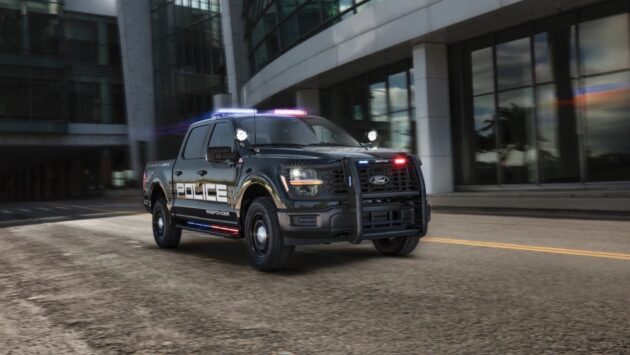
2024 Ford F-150 Police Responder from Ford Motor Company. Photo: Ford Motor Company
The 2023 Michigan State Police tests saw the introduction of the Ford Mustang Mach E, and for 2024 there is further competition in the plug-in electric lineup with the introduction of GM’s Chevrolet Blazer EV. While acceleration and top speed of full-electric vehicles are impressive, there are still few full-electric vehicles in day-to-day service as regular patrol vehicles. Time will tell if they are suited for the daily grind of police work plus act as a comfortable office to two fully-winter-kitted officers for an entire shift.
Vehicles
The Michigan State Police Precision Driving Unit evaluates police vehicles in two categories: police category vehicles and special service vehicles. Police category vehicles are designed for the full spectrum of general police activities including high-speed pursuit. Special service vehicles are designed only for specialized duties such as canine units or adverse weather conditions and are not intended or recommended for pursuits.
Twelve vehicles were submitted to the NIJ in the Police Category for the 2024 model year:
- 2024 Chevrolet Tahoe PPV 5.3L RWD
- 2024 Chevrolet Tahoe PPV 5.3L 4WD
- 2024 Chevrolet Silverado Z7X 5.3L 4WD 2-inch lift package
- 2024 Chevrolet Silverado Z71 5.3L 4WD
- 2024 Chevrolet Police Blazer EV AWD
- 2024 Dodge Durango Pursuit 5.7L AWD
- 2024 Dodge Durango Pursuit 3.6L AWD
- 2024 Ford Police Interceptor Utility 3.0L EcoBoost AWD
- 2024 Ford Police Interceptor Utility Hybrid AWD
- 2024 Ford Police Interceptor Utility 3.3L AWD
- 2024 Ford F-150 Police Responder 3.5L EcoBoost 4WD
- 2024 Ford Mustang Mach-E electric AWD
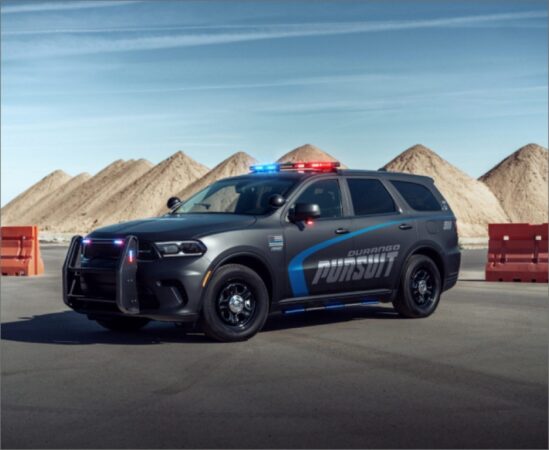
2024 Dodge Durango Pursuit from Fiat Chrysler Automobiles. Photo: Fiat Chrysler Automobiles
The tests
Michigan State Police Precision Driving Unit and the NIJ’s Justice Technology Information Center (JTIC) test all the vehicles together over a three-day period at the Chrysler Proving Grounds and the Grattan Raceway. Each vehicle is tested without rooftop lights, spotlights, sirens or radio antennas in place. Tires are original equipment rubber provided by the manufacturer.
Acceleration, braking and top speed tests are performed at the Chrysler Proving Grounds and vehicle dynamics tests are done using the two-mile road course at the Grattan Raceway. (All dimensions and measurements are given in U.S. numbers.)
The Michigan State Police yearly vehicle test for the 2024 model year will mark the 26th year that Blue Line has been compiling and reporting the results of the tests for pursuit-rated police category vehicles.
The Results
Vehicle dynamics testing
The objective of the vehicle dynamics testing is to determine the high-speed pursuit handling characteristics. Except for the absence of traffic, the two-mile road course simulates actual pursuit conditions. It evaluates the blend of suspension components and acceleration and braking ability. Four different drivers test each vehicle over an eight-lap road course, with the five fastest laps counting toward each driver’s average lap time. Final score is the combined average of all four drivers for each vehicle.
Electric-powered vehicle dynamics testing
Because of the unique nature of battery electric vehicles, it was felt that a fair assessment of their capabilities would involve fast-charging the battery pack between runs. This would be more typical of an electric vehicle hitting the road near the start of every shift. In discussions with all three manufacturers, the MSP Precision Driving Unit settled on a charge time of 40 minutes on a 47 Kw Level 3 charger between runs.
Acceleration and top speed
The objectives of the acceleration and top speed tests are to determine the ability of each vehicle to accelerate from a standing start to 60 mph, 80 mph and 100 mph, and to record the top speed achieved within a distance of 14 miles from a standing start. Each vehicle is driven through four acceleration sequences, two in each direction to allow for wind. Acceleration score is the average of the four tests. Following the fourth acceleration sequence, each vehicle continues to accelerate to its highest attainable speed within 14 miles of the standing start point.
Braking
The objective of the braking test is to determine the deceleration rate attained by each vehicle on twenty 60-0 mph full stops to the point of full ABS. Each vehicle is scored on the average deceleration rate it attains.
Each test vehicle makes five measured 60-0 mph stops to full ABS engagement in one direction, and then five measured 60-0 mph stops to full ABS engagement in the opposite direction. After ten stops, each vehicle completes one lap around the test oval to cool the brakes, and the test is repeated. The resulting score is the average of all 20 stops. Stopping distance from 60 mph is calculated by interpolation of results.
Communications and ergonomics
The objectives of the communications and ergonomics tests are to rate a vehicle’s ability to provide a suitable environment for patrol officers to perform their job, to accommodate required communication and emergency warning equipment and to assess the relative difficulty in installing this equipment. A minimum of four officers independently evaluate ergonomic factors, and Michigan State Police Communications Division personnel then evaluate each vehicle on the ease of equipment installation. A score of one represents “totally unacceptable” and a score of 10 represents “superior” ergonomic or communication installation factors.
Twenty-seven ergonomic factors are evaluated on a scale of one to 10 and averaged among all the testers. The final score is the overall average of all 27 factors, such as seat design, padding, ease of entry, head room, instrument placement, HVAC control placement, visibility and ease of entry and exit.
A total of three communications factors are evaluated on a scale of one to ten and averaged among all the testers. The final score is the overall average of all three factors, including dashboard, trunk and engine compartment accessibility.
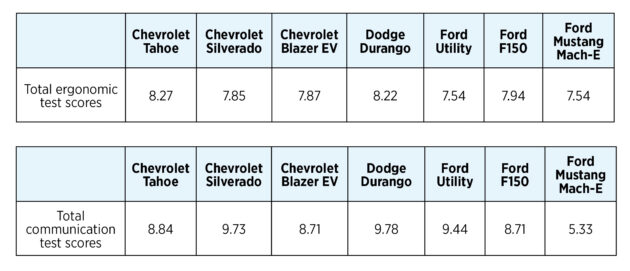
Fuel economy
While not an indicator of actual mileage that may be experienced, the EPA mileage figures serve as a good comparison of mileage potential from vehicle to vehicle. Vehicle figures are based on data published by the vehicle manufacturers and certified by the U.S. Environmental Protection Agency. Mileage figures are given in U.S. miles per gallon.
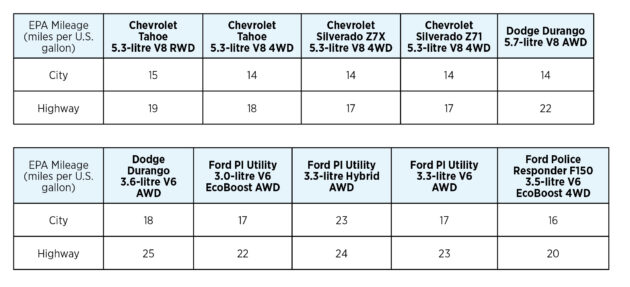
Dave Brown is a Blue Line contributor on firearms and police vehicles, as well as a Best Dressed Police Vehicle Awards judge. He is a tactical firearms trainer and consultant based in Winnipeg. He can be reached at dave@bulletproofset.ca.
Print this page